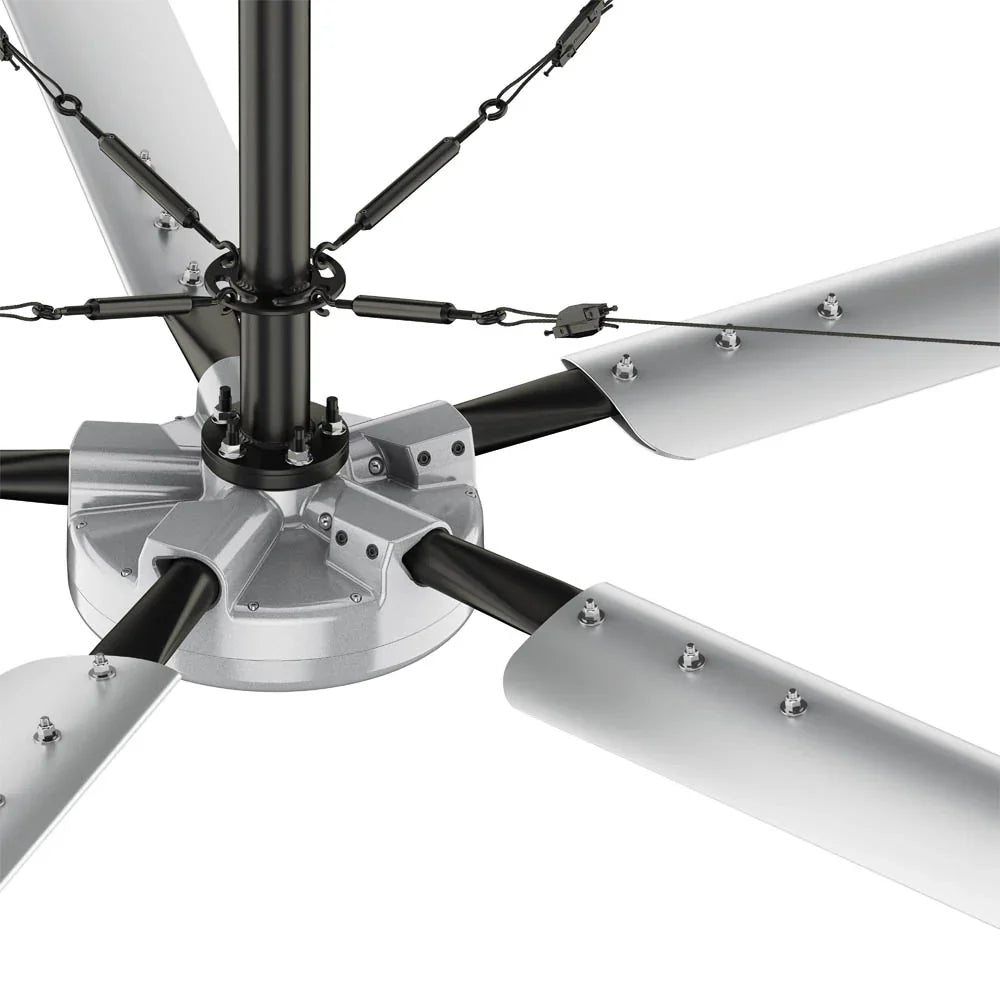
Fan Blade Design and Airflow
Fan blade design is a key factor in airflow efficiency, energy consumption, and cooling performance. And in large commercial spaces like warehouses, manufacturing plants, and distribution centers, airflow can impact productivity, air quality, and energy costs. The right fan blade shape can determine how well air circulates, how much energy a fan consumes, and how effective it is in managing temperature and ventilation.
That’s why it’s so important to know how blade design works and how it affects airflow. In this article, we’ll break down how fan blade design impacts performance, what makes the most efficient fan blade design, and what to look for when selecting a fan for your facility. Let’s get started!
How Does Fan Blade Design Affect Airflow?
The way a fan moves air depends entirely on its blade design, angle, and shape. A poorly designed fan might spin rapidly but move very little air, while a well-engineered fan with the right blade shape can push significant amounts of air at lower speeds. Here are some key factors that influence fan blade design airflow:
-
Blade Length: Longer blades can move more air per rotation, which is why HVLS fans are so effective in large spaces.
-
Blade Angle (Pitch): A higher pitch moves more air but requires more power, while a shallow pitch can be more energy efficient.
-
Blade Shape: The curvature and tapering of a fan blade can affect how smoothly air moves, reducing turbulence and improving efficiency.
-
Blade Count: More blades don’t always mean better airflow. In fact, sometimes fewer, wider blades are more effective at moving large volumes of air.
What is the Most Efficient Fan Blade Design?
The most efficient fan blade design is one that moves the most air with the least effort. But depending on your space, that could mean something different. Here’s a closer look at the aspects that make a fan blade efficient.
1. Aerodynamic Shape
Fans with airfoil-style blades, like airplane wings, are the most efficient. These blades reduce drag and create a smooth, controlled airflow pattern, maximizing air movement while keeping energy consumption low.
2. Long, Slow-Moving Blades
HVLS fans use longer blades spinning at lower speeds to move air efficiently across large areas. This is why a single HVLS fan can provide cooling for an entire warehouse, whereas multiple smaller fans would struggle to achieve the same effect.
3. Optimized Blade Pitch
Blade pitch determines how much air a fan moves per rotation. If the pitch is too shallow, airflow is weak. If it’s too steep, the fan consumes too much power. The best fan blade design should perfectly balance pitch and motor efficiency.
4. Balanced Blade Count
Contrary to popular belief, more blades don’t always mean better airflow. Industrial fans often perform best with three to six wide blades rather than a large number of narrow blades.
Fan Blade Shapes and Their Impact on Airflow
Not all fan blades are created equal. The shape of the blade has a direct impact on how well it moves air. Here’s a closer look at some of the most common fan blade shapes and how they impact airflow:
-
Flat Blades: These generate less airflow and require more speed to be effective.
-
Curved Blades: These are more effective than flat blades, as they create smoother airflow with less turbulence.
-
Airfoil Blades: This is the best fan blade design for efficiency. They mimic aircraft wings to push air smoothly with minimal energy use.
-
Twisted or Helical Blades: These blades improve multidirectional airflow and are useful for some applications.
So, which is the best? For commercial and industrial settings, airfoil blades are the gold standard. They offer the most energy-efficient fan blade design airflow, moving large volumes of air with minimal power.
How to Find the Best Fan Blade Design for Your Facility
If you want to pick the best fan blade design for your space, you need to think about blade shape, length, material, and pitch.
-
Blade Shape: Airfoil blades are the most efficient option for large-scale airflow, as they minimize drag while maximizing air movement.
-
Blade Material: Aluminum and composite materials hold up best in industrial environments because they offer corrosion resistance and high durability levels.
-
Blade Pitch and Length: Blade pitch and length must be balanced to achieve energy efficiency and airflow effectiveness, ensuring that air reaches all necessary areas without excessive power consumption.
-
Fan Motor: And finally, you need to think about your fan’s motor. With the right motor, your fan should operate efficiently and produce the ideal amount of circulation for your space.
TBC Supply: Your Source for High-Performance Industrial Fans
At TBC Supply, we specialize in HVLS fans, directional fans, and industrial airflow solutions designed for warehouses, factories, and commercial facilities. Our fans feature the most efficient fan blade design to optimize airflow while keeping energy costs low.
Whether you need a powerful HVLS fan for wide-area cooling or high-performance directional fans for targeted airflow, we have the best fan blade design options for your needs. With a commitment to top-tier brands and fast, reliable service, we provide airflow solutions that enhance comfort, efficiency, and energy savings. Schedule a free site visit consultation today!
